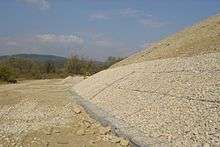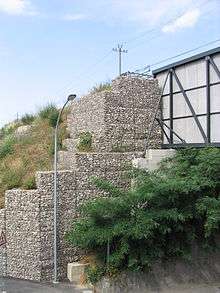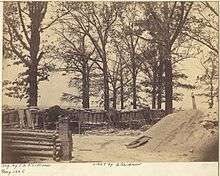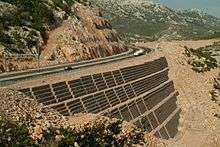Gabion
A gabion (from Italian gabbione meaning "big cage"; from Italian gabbia and Latin cavea meaning "cage") is a cage, cylinder or box filled with rocks, concrete, or sometimes sand and soil for use in civil engineering, road building, military applications and landscaping.


For erosion control, caged riprap is used. For dams or in foundation construction, cylindrical metal structures are used. In a military context, earth- or sand-filled gabions are used to protect sappers, infantry, and artillerymen from enemy fire.
Leonardo da Vinci designed a type of gabion called a Corbeille Leonard ("Leonard[o] basket") for the foundations of the San Marco Castle in Milan.[1]

Civil engineering
The most common civil engineering use of gabions was refined and patented by Gaetano Maccaferri in the late 19th century in Sacerno, Emilia Romagna and used to stabilize shorelines, stream banks or slopes against erosion. Other uses include retaining walls, noise barriers, temporary flood walls, silt filtration from runoff, for small or temporary/permanent dams, river training, or channel lining. They may be used to direct the force of a flow of flood water around a vulnerable structure.
Gabions are also used as fish screens on small streams. Gabion stepped weirs are commonly used for river training and flood control; the stepped design enhances the rate of energy dissipation in the channel, and it is particularly well suited to the construction of gabion stepped weirs.[2]
A gabion wall is a retaining wall made of stacked stone-filled gabions tied together with wire. Gabion walls are usually battered (angled back towards the slope), or stepped back with the slope, rather than stacked vertically.
The life expectancy of gabions depends on the lifespan of the wire, not on the contents of the basket. The structure will fail when the wire fails. Galvanized steel wire is most common, but PVC-coated and stainless steel wire are also used. PVC-coated galvanized gabions have been estimated to survive for 60 years.[3] Some gabion manufacturers guarantee a structural consistency of 50 years.[4]
In the United States, gabion use within streams first began with projects completed from 1957 to 1965 on North River, Virginia and Zealand River, New Hampshire.[5] More than 150 grade-control structures, bank revetments and channel deflectors were constructed on the two U.S. Forest Service sites. Eventually, a large portion of the in-stream structures failed due to undermining and lack of structural integrity of the baskets. In particular, corrosion and abrasion of wires by bedload movement compromised the structures, which then sagged and collapsed into the channels. Other gabions were toppled into channels as trees grew and enlarged on top of gabion revetments, leveraging them toward the river channels.
Gabions have also been used in building, as in the Dominus Winery in the Napa Valley, California, by architects Herzog & de Meuron, constructed between 1995 and 1997. The exterior is formed by modular wire mesh gabions containing locally quarried stone; this construction allows air movement through the building and creates an environment of moderate temperatures inside.[6][7]
Variations in design
There are various special designs of gabions to meet particular functional requirements and some special terms for particular forms have come into use. For example:[8]
- Bastion: a gabion lined internally with a membrane, typically of nonwoven geotextile to permit use of a granular soil fill, instead of rock.
- Mattress: a form of gabion with relatively small height relative to the lateral dimensions; commonly very wide. For protecting surfaces from wave erosion and similar attack, rather than building or supporting high structures.[9]
- Trapion: a form of gabion with a trapezoidal cross section, designed for stacking to give a face that is sloping rather than stepped. The term is in wide usage, but in contexts related to gabions at least, appears to be a trademark registered by Betafence Limited.
Military use

Early gabions were round cages with open tops and bottoms, made from wickerwork and filled with earth for use as military fortifications.[10]:38 These early military gabions were most often used to protect sappers and siege artillery gunners.[10]:39 The wickerwork cylinders were light and could be carried relatively conveniently in the ammunition train, particularly if they were made in several diameters to fit one inside another. At the site of use in the field, they could be stood on end, staked in position, and filled with soil to form an effective wall around the gun, or rapidly construct a bulletproof parapet along a sap. During the Crimean War, local shortages of brushwood led to use of scrap hoop-iron from hay bales in its stead; this in turn led to purpose-built sheet-iron gabions.[10]:182
Today, gabions are often used to protect forward operating bases (FOBs) against explosive, fragmentary, indirect fires such as mortar or artillery fire. Examples of areas within a FOB that make extensive use of gabions are sleeping quarters, mess halls, or any place where there would be a large concentration of unprotected soldiers. Gabions are also used for aircraft revetments, blast walls, and similar structures.
See also
| Wikimedia Commons has media related to Gabions. |
| Wikisource has the text of the 1911 Encyclopædia Britannica article Gabion. |
- Cellular confinement, a small-scale mattress gabion used for roads, retaining walls, and protective structures.
- Hesco bastion, a modernized version of the same concept
- Maccaferri gabion, wire mesh gabions introduced into modern civil engineering
- Stepped spillway
References
- gabiondesign.be Archived January 6, 2008, at the Wayback Machine
- Wüthrich, Davide; Chanson, Hubert (September 2014). "Hydraulics, Air Entrainment, and Energy Dissipation on a Gabion Stepped Weir". Journal of Hydraulic Engineering. 140 (9): 04014046. doi:10.1061/(ASCE)HY.1943-7900.0000919. ISSN 0733-9429.
- maccaferri-northamerica.com Archived March 11, 2012, at the Wayback Machine
- "Feature Projects - Project 2". gabions.net. Retrieved 22 November 2014.
- Toblaski, R.A., and N.K. Tripp, 1961. Gabions for stream and erosion control. Journal of Soil and Water Conservation 16: 284-285.
- "Dominus Winery in Napa Valley, California, USA". floornature.com. Retrieved 2009-02-22.
- "Dominus Winery". Archiplanet. Archived from the original on 2008-10-14. Retrieved 2009-02-22.
- ridgeway-online.com
- foraas.no
- Mahan, Dennis Hart (1870). An elementary course of military engineering. New York: Wiley. Retrieved 7 June 2017.
- Freeman, Gary E.; Fischenich, Craig J.(May 2000), "Gabions for Streambank Erosion Control", Environmental Laboratory, U.S. Army Corps of Engineers.
- University of New South Wales Water Research Laboratory, Research Report No. 156, "Some factors affecting the use of Maccaferri gabions and reno mattresses for coastal revetments", October 1979, C. T. Brown, et al.

